10 FACTS ABOUT BUYING JADEITE JADE BANGLES
A comprehensive guide to Burmese Jade Bangles and Bracelets
2020 Edition
What is Authentic Jade?
When it comes to Genuine Jade, one can refer to them as either Jadeite or Nephrite. Two different minerals but are alike in appearance. But wait...there are many other materials that looks like Jade too, and traders around the world are calling them Jade because it brings the value up of their product. These are what most might call "fake" jade, the non-genuine. As a buyer looking for Authentic Jade, it can be very confusing, maybe even daunting to get the best deal while making sure the piece is authentic. Fear not, by the end of this article you will have all the knowledge to buy Authentic Jade Bangles. In this guide, we will cover the more valuable and sought after Jadeite Jade. We will discuss its value, colour, translucency, texture, colour, artificial treatments, origin, and everything else you will need to know to choose the right bangle.
Jadeite or Nephrite
Firstly, know which type of Jade you are going to buy. Nephrite or Jadeite, they are both real, authentic Jade. If you are looking for the same Chinese Jade Bangles that gets sold for millions of dollars at auction and was worn by the traditional Chinese imperial families, then you are looking for Jadeite Jade. Although they similar in appearance, their chemical compositions are very different. Jadeite has a higher hardness and is more durable. Nephrite is less lustrous and almost always opaque. Jadeite comes in a wider variety of colour while Nephrite generally comes in darker, more matte tones. Nephrite is commonly found in large deposits around the world and it’s generally used for carving because of its availability. Jadeite is a much rarer mineral and commercially only available from Myanmar (Burma).
Imitation (Fake) Jade
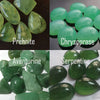
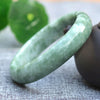
Guizhou Jade
A recent survey of the Jade Bangle market shows a large amount Guizhou Jade Bangles from China being sold as "Natural Certified Jadeite Jade" Bangles. Don't be fooled. Guizhou Jade is a type of Green Quartzite, a metamorphosized sandstone.
Treatments
Grade / Type | Treatment | Comments |
|---|---|---|
| A | None / Waxing | Natural untreated jade |
| B | Bleached, then impregnated with a polymer to enhance translucency and colour | Low value, Losses durability and not stable |
| C | Dyed to improve colour | Low value, Colour change or fade over time |
| B + C | Translucency and colour enhanced | Low value, as above |
| D | Composite material | Jadeite combined with other material such as plastics or glass |

A man paints on dyes onto a Jade Bangle to mimic natural looking colour veins and inclusions.
TYPE C Jade Bangles Floods Myanmar Jade Market
A recent market update from Myanmar shows the Jade market in Myanmar is now flooded with dyed, Grade C Jadeite Jade Bangles. The Burmese rarely treat their Jade products but as of the last recent years, treatments are becoming more common and in some cases, they are becoming the new norm. The majority of the world's Jade bangle supply comes from Burma. For this reason, we need to be aware of these treatments that can affect the value of a Jade bangle greatly. Read more: Dyed Jade Bangles in Myanamar.

Degradation of polymer on the surface revealing a bleached area.

Graph showing the value of natural vs treated jade over time.

Internal degradation of polymer showing discolouration.
Colours of Jadeite Jade
Natural Jadeite can come in many colours: green, lavender, red, orange, yellow, brown, grey, black, and white. The most sought after the colour of Jadeite is called the Imperial Green which is an Emerald like vivid green colour. It's closely followed by Lavender Jade which has a purplish blue hue. Icy Jade is coming into trend with its near transparent white colour.
Translucency
Like many other gemstones, the transparency of Jadeite Jade is a factor in determining the quality. Myanmar Jadeite Jade can range from near transparent to opaque. Opaque Jade bangles are considered lesser in value because they are plentiful. The value of a jade bangle can increase dramatically even with the slightest improvement translucency.
Texture
Texture of the material plays an important factor in determining a value of a jade bangle. High value jadeite is fine or smooth in texture and does not have a coarse granular look.
Imperfections
Jadeite Jade being a product of nature, created through tremendous heat and pressure, usually have natural flaws. They are only avoidable to an extant because of the way these bangles are carved out of the rough mineral. Carving out a perfect piece would mean wasting precious material and even then, it's not guaranteed to bring out a flawless bangle. Perfect bangles are possible (with some luck and miracle), however, they are rare and carries a higher premium. These flaws or inclusions do not affect the durability of the bangles. In fact, it gives it a uniqueness. A fingerprint of sorts. In most scenarios, these natural flaws are strong indicators that a bangle hasn't been artificially treated. Some common inclusions in Burmese Jade Bangles are shown on the diagram to the right.
Flaws and Value
Imperfections or flaws as some may put it, is one of the key considerations in determining the value of a jade bangle bracelet. Many shopping for a jade bangle online may overlook this important factor to opt for a cheaper option. A single critical flaw or multiple flaws can have significant impact (up-to 90% reduction) on the pricing depending on the severity of the flaw. For example, 2 bangles that look entirely similar in colour, texture and translucency. One is priced at $55 and the other, $550. One is flawless and the other has a critical flaw that might affect the structural integrity of the bangle. Which also means a light impact to the bangle may cause it break into pieces. There are many examples evident through our collection; similar looking bangles carved out of the same stone but varying greatly in prices. Every single bangle available through us has gone through rigorous inspections to check for flaws in determining its value.
| Flaw Type | Severity |
|---|---|
| Internal Stonelines | Low - Moderate |
| Surface Reaching Fractures | Low - High |
| Veins | Low |
| Chips | Low - Moderate |
| Dents | Low - Moderate |
| Symmetry | Low - Moderate |
| Surface Blemishes | Low - Moderate |

World's Most Expensive Jade Bangle
The current world record price for Jadeite bangle is currently at $7.8M AUD ($5.6M USD) set in 2015 at Sotheby's Hong Kong. It was a Guifei bangle; an oval shaped bangle for imperial consorts pioneered during the Tang Dynasty. But as of recently (2018) a highly translucent, imperial green coloured jadeite bangle named The Circle of Heaven has been offered with an estimate price more than double the current record. See the Top 10 most expensive bangles article.
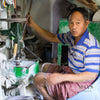
The driller uses a specialised drilling machine to form rough jadeite bangles.
How Jade Bangles are Made
Jade Bangles are made by craving from large natural boulders which are then sliced in to manageable slabs. Holes are drilled out of these slabs to create a rough jade bangle. From the rough, skilled men shaped them into various styles just with the use of the hands. They are finally polished in a traditional manner just like from ancient times. See the whole jade bangle production process from boulder to bangle with photos here.

Jade Bangle Styles
Myanmar Jadeite Jade Bangles comes in six different styles. The diagram on the left shows the cross section of a bangle. Traditionally, Jade bangles were worn with a Round or Oval style. Over time, the trend is progressing towards Halfmoon and Flat styles. Partly due to the decreasing amount of good translucent material. A thinner, flatter style allows more light to pass through making the bangle appear more translucent. Nevertheless, round styles are still popular and is a matter of personal preference.

Maintenance and Care
Caring for a Natural Jade Bangle requires very little. The material itself is very tough and will resist to chips and breaks. Regular cleaning is recommended to maintain your bangle's original lustre (shine). Read this expert's guide to cleaning, waxing and caring for Jade Bangles, natural or treated.
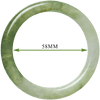
Sizing
Jadeite Jade Bangles are non-flexible, made out of solid mineral. Sizes refer to the internal diameter as shown below in millimetres. The usual sizes are from 54mm - 66mm. Follow this Jade Bangle Sizing Guide to determine the correct fitment.
Benefits of Wearing a Jade Bangle
Jadeite Jade is a symbol of wealth, health and protection in Chinese culture. The Chinese have treasure this gemstone for centuries because it is believed to bring the wearer wealth and good fortune.
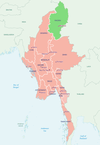
Origin
The finest source of Jadeite Jade in the world comes from Kachin state, Myanmar (Burma). It's also the only commercial source for Jadeite in the world. Other small deposits are found in Kazakhstan, Russia, Japan, Guatemala, and USA.
Colour Change Over Time
There are reported cases of Grade A Jadeite Jade bangles changing colour over time from wear. It’s important to note that colour change in treated jadeite is different topic. If the colour change from green to brownish colour, it is believed that the bangle has been drawing negative energy from your body. On the other hand, if the bangle turns greener, the bangle has been deposited with positive energy over time. The process may take years to notice and it's important to note that there is no scientific explanation to the process. Perhaps it's supernatural.
Mineral Properties
| Chemical Formula | NaAlSi2O6 (Sodium Aluminium Silicate) |
|---|---|
| Hardness | 6.5 - 7 |
| Crystal System | Monoclinic |
| Transparency | Near transparent – Opaque |
| Specific Gravity | 3.3 - 3.5 |
| Reflective Index | 1.654 – 1.673 |
| Birefringence | 0.019 |
| Lustre | Vitreous – Waxy |
Misnomers
| Trade Name | Mineral |
|---|---|
| Burmese, Yunnan, Imperial Jade | Jadeite |
| Chinese, Canada, Russian, Wyoming Jade | Nephrite |
| New Zeland Greenstone | Nephrite or Bowenite |
| Indian, Amazon Jade | Aventurine |
| Manchurian, Shanghai, Fujian, Honan Jade | Green Talc |
| Guizhou, Malaysia Jade | Quartzite |
| Australian Jade | Chrysoprase |
| California, American Jade | Vesuvianite |

WAI YAN

























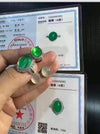


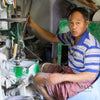



Hi, I want to get a jade ring, but not sure what size I should get. My finger circumference is 60 mm. Thank you!
Hello Karen,
Silk Quartzite is a trade name given to Quartzite that has silk-like pattern inclusions. Quartzite does not belong to any types of Jade.
Hi Thank you for that great information. Just a question really, where does Silk Quartzite ‘Jade’ fit into the Jade family if at all.
Many Thanks
Kind regards
Karen